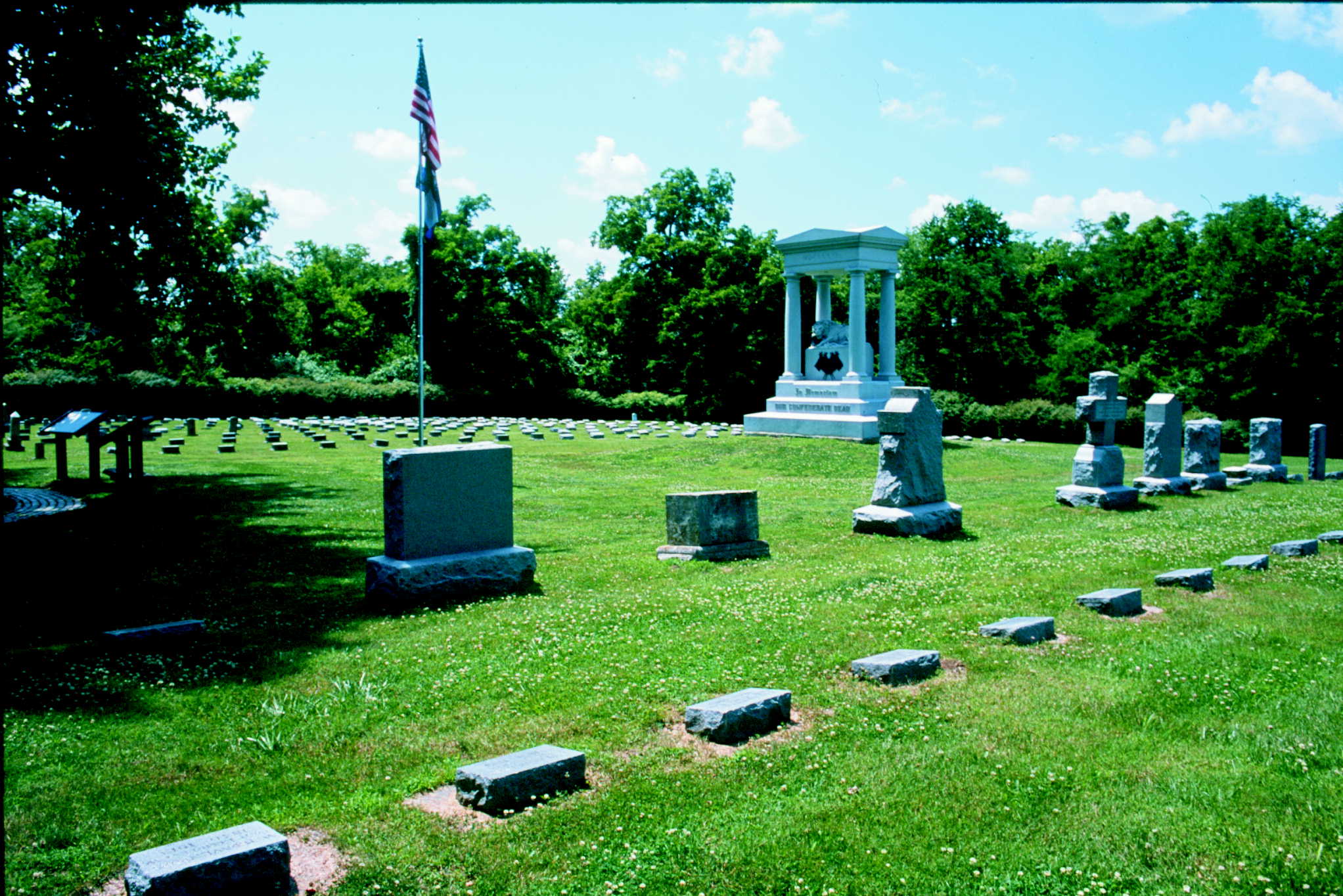at Confederate Memorial State Historic Site
Missouri's Confederate Home
 In 1889, almost 25 years after the Civil War ended, a group of Missouri Confederate veterans gathered in Higginsville for their annual reunion. While meeting to remember old times and past glories, these men recognized the need to establish a haven for their less fortunate comrades. Throughout the state, veterans and interested parties joined forces and founded the Confederate Home Association. Many who gave were former Union soldiers. Within a year, the association raised enough money to purchase 365 acres of prime farmland just north of Higginsville. Many of those funds were raised by the Daughters of the Confederacy in Missouri, through statewide fundraising efforts. The Daughters of the Confederacy in Missouri also raised funds for the building and furnishing of the small three-to-four-room cottages at the home. In April 1891, Julius Bamberg became the first veteran admitted to the Confederate Soldiers Home of Missouri. Over the next 59 years, more than 1,600 veterans and their wives, children and widows would seek shelter at the home.
In 1889, almost 25 years after the Civil War ended, a group of Missouri Confederate veterans gathered in Higginsville for their annual reunion. While meeting to remember old times and past glories, these men recognized the need to establish a haven for their less fortunate comrades. Throughout the state, veterans and interested parties joined forces and founded the Confederate Home Association. Many who gave were former Union soldiers. Within a year, the association raised enough money to purchase 365 acres of prime farmland just north of Higginsville. Many of those funds were raised by the Daughters of the Confederacy in Missouri, through statewide fundraising efforts. The Daughters of the Confederacy in Missouri also raised funds for the building and furnishing of the small three-to-four-room cottages at the home. In April 1891, Julius Bamberg became the first veteran admitted to the Confederate Soldiers Home of Missouri. Over the next 59 years, more than 1,600 veterans and their wives, children and widows would seek shelter at the home.
Needy and incapacitated former soldiers and sailors from across the South resided at the home after proving their service record, their financial need and their two or more years of Missouri residency. Most had been infantry, artillery or cavalry privates, but others had served as officers, sharpshooters, partisan guerrillas, musicians, paid conscription substitutes, naval personnel on the first ironclads, and even spies. Collectively, they had participated in every theater of war and in every major battle, from the first shots fired at Fort Sumter to the Confederate surrender at Appomattox. Veterans from the border states and all but one of the Confederate states lived and died at the home. Unlike other Southern veterans institutions, Missouri's home admitted women and children from its beginning.
By the mid-1890s, the Confederate Home faced a serious financial crisis. Insufficient funding, due in part to a nationwide depression, forced the home's board to appeal to the state for assistance. The state took over financial control of the home in 1897, but a board of trustees made up of Confederate veterans continued to oversee its operation.
 As the years passed and the Civil War veteran population aged, the home continued to grow. At its height, the home annually cared for more than 380 veterans and their families, and the property consisted of 30 buildings, a thriving farm and dairy, and a memorial park. The home generated its own electricity and steam heat, and in many ways it was a community unto itself.
As the years passed and the Civil War veteran population aged, the home continued to grow. At its height, the home annually cared for more than 380 veterans and their families, and the property consisted of 30 buildings, a thriving farm and dairy, and a memorial park. The home generated its own electricity and steam heat, and in many ways it was a community unto itself.
On May 8, 1950, the last surviving Missouri Confederate soldier, Johnny Graves, died at the home at the age of 108. He was buried alongside 800 others in the site's cemetery. The state transferred the four remaining widows to a nursing home, officially closing the Confederate Soldiers Home of Missouri.
Soon after the home’s closing, another state agency appropriated much of the property and demolished many of the dilapidated buildings. However, the Missouri State Park Board took over management of the remaining property, consisting of the 90-acre Confederate Memorial Park, the cemetery and one cottage.
Today, Confederate Memorial State Historic Site protects the memories of the veterans and family members who lived at the home, and the staff who took care of them during their time at the home. The grounds include five structures over a century in age: the chapel and cemetery (both listed on the National Register of Historic Places), the cottage, a farmhouse, and the hospital building. Visitors today can experience these features and enjoy the park’s seven small ponds, old hardwood trees and beautifully kept picnic areas.






